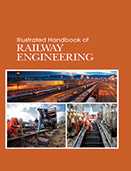Engineering and Technology

There have been major technological developments in railways around the world in the recent past to meet the challenges of heavier traffic and higher speeds. In Railways especially, the track structure has been modernized in a big way in the last three decades. Long welded rails, concrete sleepers, and elastic fastenings have been used on high speed routes to provide stable and resilient structures. Metro railways are also being introduced in metropolitan cities to ease the problem of jamming on roads.
Illustrated Handbook of Railway Engineering deals with all aspects of railway engineering, from fundamental concepts to modern technological developments. The text presents the theories and practices as well as the modern techniques in detail.
The objective for the railway sector is to ensure an optimal level of service quality and variety (including public interest considerations) and a high level of productive efficiency (and therefore a minimum level of subsidy where one exists), subject to efficient pricing of rail services to end-users (taking into account the price of substitute services, which are often subsidized), an optimal level of service quality and variety (including public interest considerations), and a high level of productive efficiency (and therefore a minimum level of subsidy where one exists). Reform in the railway sector, as in other utilities, is driven by a public policy perception that this objective can often best be pursued by promoting competition where it can be sustained.
This Illustrated Handbook of Railway Engineering aims to introduce these basic concepts on which virtually all more elaborate methods are building up. It will cover a wide range of frequently encountered ground states, starting with the theory of metals and semiconductors, proceeding with magnets, Mott insulators, and finally superconductors.